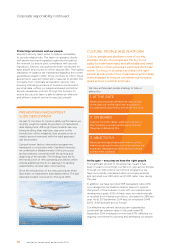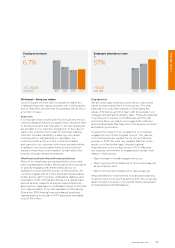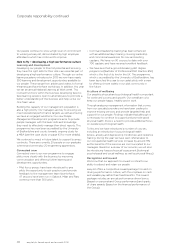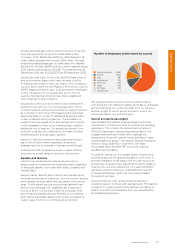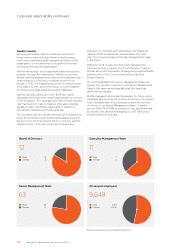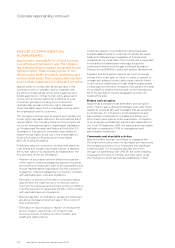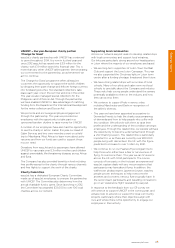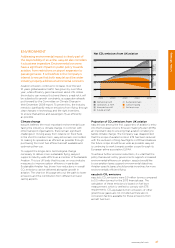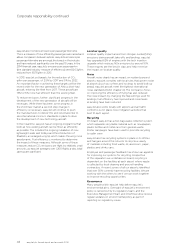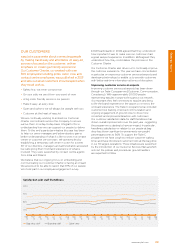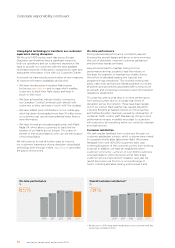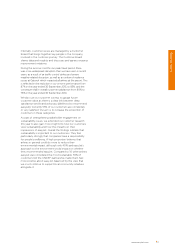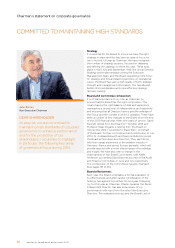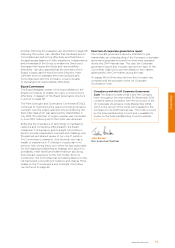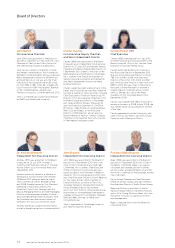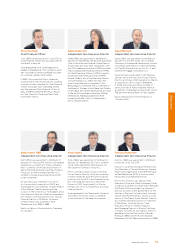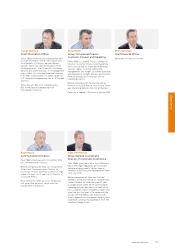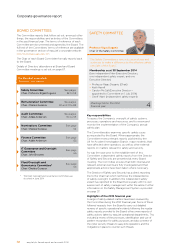EasyJet 2014 Annual Report Download - page 50
Download and view the complete annual report
Please find page 50 of the 2014 EasyJet annual report below. You can navigate through the pages in the report by either clicking on the pages listed below, or by using the keyword search tool below to find specific information within the annual report.Corporate responsibility continued
easyJet also monitors emissions per passenger kilometre.
This is a measure of how efficiently passengers are carried and
allows comparison between airlines. easyJet’s emissions per
passenger kilometre are amongst the lowest in the industry
and have reduced significantly over the past 10 years. In the
2014 financial year, easyJet’s emissions per passenger km
(the standard industry measure of efficiency) were 82.03g/km,
reduced from 83.76g/km in 2013.
In 2013, easyJet set targets for the reduction of CO2
g/km per passenger, of 2.5% by 2017 and 5% by 2022.
An important factor in achieving these targets will be the
recent order for the new generation of Airbus short-haul
aircraft, entering the fleet from 2017. These aircraft are
13% to 15% more fuel efficient than the existing fleet.
To reduce emissions further, significant progress in the
development of the new generation of aircraft will be
necessary. While there has been some progress in
the short-haul market a second step change in
efficiency is necessary. easyJet will continue to push
the manufacturers to deliver this and would also like to
see international minimum standards in place to drive
the development of new technology aircraft.
In the meantime, easyJet has an ongoing programme that
looks at how existing aircraft can be flown as efficiently
as possible. This includes the ongoing installation of new
lightweight seats and trolleys and the introduction of
Sharklets; an enlarged wing tip which makes the wing more
aerodynamic. Fuel efficiency is monitored to determine
the impact of these measures. Although some of these
measures reduce CO2 emissions per flight by relatively small
amounts, as easyJet averages over 1,200 flights a day, total
savings are significant.
Local air quality
Local air quality impact arises from nitrogen oxides (NOx)
emissions during aircraft take-offs and landings. easyJet
has upgraded 62% of engines with the tech insertion
upgrade which reduces NOx emissions by around 10%.
These engines are the best in class and help minimise
the impact on local air quality.
Noise
Aircraft noise clearly has an impact on residents around
airports. easyJet complies with local rules that govern noise
at airports (such as curfews and routings to avoid built-up
areas). easyJet aircraft meet the tightest international
noise standards (ICAO chapter 4). The Company’s focus
on improving the efficiency of flying has also reduced
the noise impact; by changing the flap settings used for
landings, fuel efficiency has improved and noise levels
at landing have been reduced.
easyJet also works locally with airports and air traffic
control to put in place noise mitigation activities that
best fit each airport.
Recycling
On board, easyJet has a two-bag waste collection system
which separates recyclable material such as newspapers,
plastic bottles and metal cans from general waste.
Poster campaigns have been used to promote recycling
to cabin crew.
easyJet also has recycling systems in place in its offices
and hangars around the network to recycle a variety
of materials including food waste, oil, aluminium, paper,
plastics and drinks cans.
Employee and passenger feedback has shown an appetite
for improving our systems for recycling. Irrespective
of the separation we undertake on board, recycling is
dependent on the facilities at each airport where waste
is collected by local cleaning and ground handling
contractors. A recent survey of all our airports identified
that over 50% currently have recycling facilities. We are
working with the others to see if we can work together
to improve recycling opportunities.
Governance
Many people within easyJet help deliver easyJet’s
environmental aims. Oversight of easyJet’s environment
policy is carried out by its regulatory team, and the
Executive Management Team and Chief Executive receive
regular updates on environmental policy as part of
reporting on regulatory issues.
48 easyJet plc Annual report and accounts 2014


